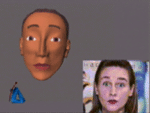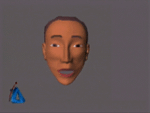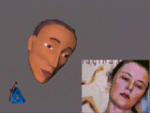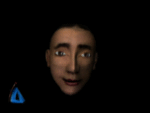Analyse et synthèse temps réel du visage pour la télévirtualité
Image(s): 640*480
 Jpeg Image (32 Ko)
Jpeg Image (32 Ko)
|
 Jpeg Image (20 Ko)
Jpeg Image (20 Ko)
|
 Jpeg Image (30 Ko)
Jpeg Image (30 Ko)
|
 Jpeg Image (10 Ko)
Jpeg Image (10 Ko)
|
Author(s)
-
Agnès Saulnier
- Email :
-
Marie-Luce Viaud
- Email :
-
David Geldreich
Institute(s)
-
Institut National de l'Audiovisuel
- Email :
- URL : http://www.mediaport.net
- Country : France
Project : Télévirtualité
Video(s) and extracted images: 320*240
|
Film
" Literature" |
Video QuickTime -> |
|
|
|---|---|---|---|
| Jpeg Images -> |
 (7 Ko)
(7 Ko)
|
 (6 Ko)
(6 Ko)
|
|
|
Film
" The mouth" |
Video QuickTime -> |
|
||
|---|---|---|---|---|
| Jpeg Images -> |
 (10 Ko)
(10 Ko)
|
 (10 Ko)
(10 Ko)
|
 (10 Ko)
(10 Ko)
|
|
|
Film
" The head" |
Video QuickTime -> |
|
|
|---|---|---|---|
| Jpeg Images -> |
 (10 Ko)
(10 Ko)
|
 (10 Ko)
(10 Ko)
|
|
|
Film
" The eyes" |
Video QuickTime -> |
|
||
|---|---|---|---|---|
| Jpeg Images -> |
 (11 Ko)
(11 Ko)
|
 (11 Ko)
(11 Ko)
|
 (8 Ko)
(8 Ko)
|
|
|
Film
" Expressions" |
Video QuickTime -> |
|
|
|---|---|---|---|
| Jpeg Images -> |
 (11 Ko)
(11 Ko)
|
 (11 Ko)
(11 Ko)
|
|
|
Film
" Laughing" |
Video QuickTime -> |
|
|
|---|---|---|---|
| Jpeg Images -> |
 (10 Ko)
(10 Ko)
|
 (11 Ko)
(11 Ko)
|
|
Description
A synthetic face is animated in real time from a real face. The spectator can see both faces simultaneously.
-
Date : 20:02:94
-
Category : Conferences
-
Keys Words :
- face
- image processing
- facial animation
- real time
-
Theme(s) :
Technical Information
This film has been realized on a SGI indigo for the image capture and analysis and with an extrème SGI for the synthetic face rendering.More Information...
-
Bibliography :
(2) "Real-time facial analysis and synthesis for televirtualite", Imagina's Proceedings pp173, 1994
-
Abstract :
Although the animation of virtual clones is no longer just a dream, current drawbacks limit possible applications (contact device, sensor, head immobilization in front of the camera, etc.). In this article, we propose a real-time facial animation analysis/synthesis chain which imposes few constraints. This study has been elaborated for a televirtuality context: several physically distant persons intervene in a common virtual environment via their synthetic representatives. They are thus able to share a virtual community, enter a virtual minitel, follow a visioconference, access telework operations, or even join in multi participant games. The system can be broken down as follows:- Video input
- Real image analysis: extraction of characteristic parameters
- Symbolic interpretation of parameters
- Transfer of these parameters to a remote machine
- Animation of the symbolic or realistic computer graphics clone
- Video output
-
Some external links :
-
 Televirtutality project
Televirtutality project
- http://www.mediaport.net/Ina/Recherche/TV
-
 Facial Animation
Facial Animation
- http://mambo.ucsc.edu/psl/fan.html
-
 Facial Analysis
Facial Analysis
- http://mambo.ucsc.edu/psl/fanl.html
-
-
Some internal links :
-
 Same Author
Same Author
-
 Facial animation and ageing
Facial animation and ageing
-